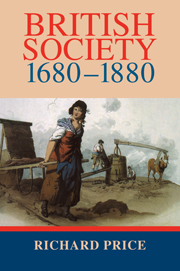Book contents
- Frontmatter
- Contents
- Preface
- Acknowledgments
- Introduction: beginnings, periods and problems
- 1 The economy of manufacture
- 2 A universal merchant to the world: the political economy of commerce and finance
- 3 The ambiguities of free trade
- 4 The reach of the state: taxation
- 5 The age of localism
- 6 The public, the private and the state: civil society 1680–1880
- 7 Exclusion and inclusion: the political consequences of 1688
- 8 Exclusion and inclusion: defending the politics of finality 1832–1885
- 9 The stabilities and instabilities of elite authority: social relations c.1688–c.1880
- Afterword
- Index
Introduction: beginnings, periods and problems
Published online by Cambridge University Press: 02 December 2009
- Frontmatter
- Contents
- Preface
- Acknowledgments
- Introduction: beginnings, periods and problems
- 1 The economy of manufacture
- 2 A universal merchant to the world: the political economy of commerce and finance
- 3 The ambiguities of free trade
- 4 The reach of the state: taxation
- 5 The age of localism
- 6 The public, the private and the state: civil society 1680–1880
- 7 Exclusion and inclusion: the political consequences of 1688
- 8 Exclusion and inclusion: defending the politics of finality 1832–1885
- 9 The stabilities and instabilities of elite authority: social relations c.1688–c.1880
- Afterword
- Index
Summary
Beginnings possess an implicit power to produce meaning. The beginning of an argument declares more than just a point of departure. It is less an innocent first place, and more the disclosure of an attitude of mind, a consciousness of understanding. A beginning anticipates the ensuing argument to a terminus that is in some sense inferred at the very outset. Sometimes this is unproblematic and uninteresting. If we are writing the military history of the First World War, the end of the book is predetermined. At other times, a beginning raises more intriguing questions. A book on the origins of the First World War, conversely, does not possess a self-declared beginning. No precise event announced the opening of a route to war and it is impossible to say without contention that this or that episode lit the long fuse to August 1914. The author has, therefore, to construct a moment to appoint as the first step to war. Similarly, to nominate a certain set of years as designating, say, the Renaissance is to declare a historical problem by a process of naming. Where we begin, therefore, may serve to define the problem we address.
To establish boundaries of beginnings and endings around historical periods may be regarded as a policing strategy. The practice of boundary setting involves the installation of a series of premises and assumptions which determine what follows. Where we start and where we end and how we get there do not lie implicit and latent in the matter of history itself, waiting only to be teased out by the skilled historian.
- Type
- Chapter
- Information
- British Society 1680–1880Dynamism, Containment and Change, pp. 1 - 16Publisher: Cambridge University PressPrint publication year: 1999



